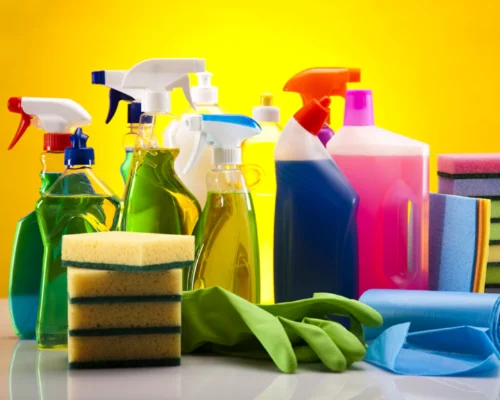
Cleaning and Home Care Specialist
Author Bio:
Yeshi Johanna is a Cleaning and Home Care Specialist who shares practical tips, research-backed methods, and professional insights to help people maintain cleaner, healthier spaces. With a strong focus on eco-friendly solutions and time-saving practices, she writes to make cleaning simple and effective for every home. Her articles on Star Cleaner cover everything from everyday cleaning routines to deep-cleaning strategies and special care for delicate surfaces.
Featured Products
Commercial Cleaning
Stop wasting your precious free time cleaning, relax while we make your premises sparkle
Home Cleaning
Come to your home to a spotless space, let us handle the mess while you enjoy more of what matters most.
Star Cleaner Academy
Unlock your potential — get trained by industry experts and become a certified cleaning professional.

Cleaning is one of those chores that never seems to end. Whether you live in a city apartment in Sydney, a family home in Brisbane, or a coastal property in Perth, keeping your space fresh and healthy is a constant task. But here’s the thing: even with the best intentions, many of us are cleaning the wrong way.
From overloading on cleaning products to forgetting small but important details, simple mistakes can undo hours of effort. In fact, research into Australian cleaning habits shows most people spend an average of 3–4 hours per week on housework, yet over 60% admit they’re not confident their homes are truly “deep clean.” That means time and effort are often wasted on methods that don’t deliver the results we expect.
Why do these mistakes happen? Often it comes down to rushing through chores, copying bad advice from online hacks, or sticking with routines our parents taught us decades ago that no longer suit today’s surfaces, products, or lifestyles. For example, using vinegar for everything is a common tip, but vinegar isn’t an effective disinfectant for modern hygiene needs.
The good news is, with a few small changes, you can avoid these pitfalls. Let’s walk through the 10 most common cleaning mistakes Australians make—and how to avoid them. You’ll not only save time but also protect your home, your health, and even your budget.
The mistake: Many Aussies mop with hot water thinking it cleans better. But on timber and laminate floors, hot water and excess moisture can cause swelling, warping, and cracks.
Why it matters in Australia: Our climate is tough on floors. In humid regions like Queensland, floors are already prone to swelling. Add excess water and you’re fast-tracking damage.
How to fix it:
A flooring specialist quoted in Your Life Choices highlighted that “hot water works for tiles but harms wood and laminates.” The wrong mop technique could cost thousands in repairs.
The mistake: Thinking more product equals more clean. In reality, overusing detergents or sprays leaves behind sticky residue, which actually attracts dust and dirt.
Why it matters: Australians spend millions on cleaning products annually, yet studies show a large percentage is wasted through overuse.
How to fix it:
Less is more. Not only will your home stay cleaner longer, but you’ll save money and reduce chemical exposure.
The mistake: Using that same sponge for weeks or tossing a grimy mop head back into the bucket. All you’re really doing is spreading germs.
Why it matters: Microfiber cloths, a household favourite in Australia, lose effectiveness after too many washes, especially if fabric softener is used.
How to fix it:
Clean tools mean clean results. Think of them as an investment in hygiene.
The mistake: Vacuuming floors first and then dusting shelves. Dust falls, so you’ll end up re-cleaning.
How to fix it:
This “top-to-bottom” method is standard practice for professionals l because it saves time and guarantees thorough results.
The mistake: Out of sight, out of mind. But skipping areas like light switches, remotes, or behind furniture lets bacteria and dust build up.
Why it matters: Studies show remote controls can harbour more bacteria than toilet seats. Add Australia’s dust-prone climate and you’ve got hidden hot spots.
How to fix it:
The mistake: In the Aussie sun, window cleaner evaporates too quickly, leaving streaks.
How to fix it:
It might feel good to clean in the sunshine, but your results will look better if you wait for cloud cover.
The mistake: Keeping everything shut while cleaning. This traps fumes and reduces air quality.
Why it matters: In smaller Aussie apartments, this can cause headaches or irritation from concentrated cleaning agents.
How to fix it:
Fresh air is as important as fresh surfaces.
The mistake: Vacuuming with a full bag, dirty filter, or wrong attachment. This reduces suction and spreads dust back into the air.
How to fix it:
In dusty regions like rural NSW or WA, regular maintenance is crucial to keep vacuums effective.
The mistake: Bleach for everything, vinegar for everything else. Neither is always appropriate.
Why it matters:
How to fix it:
The mistake: Skipping product labels or appliance manuals. This risks damage and voided warranties.
How to fix it:
This simple habit protects your investment and ensures you’re cleaning the right way.
| Topic | Finding | Source |
|---|---|---|
| Time spent on cleaning | Aussies average 3–4 hours/week on household cleaning. | Cleanrific |
| Attitude | Majority view cleaning as a chore, not enjoyable. | Cleanrific |
| Market size | Australian cleaning services industry worth $12+ billion and growing. | IBISWorld |
| DIY habits | Over 60% of households rely on DIY cleaning but admit to knowledge gaps. | Cleanrific |
| Common damage | Improper mopping linked to warped floors in humid states. | Your Life Choices |
| Myths | Vinegar cleans but does not disinfect. | The Spruce |
Cleaning is part of everyday life in Australia, but small mistakes can cost you time, money, and even your health. From mopping with too much water to relying on vinegar as a disinfectant, the most common errors are easy to fix once you know them.
By adjusting your habits—using less product, cleaning top to bottom, and maintaining your tools—you’ll see better results with less effort. And if you’re ever too busy, uncertain, or just want guaranteed professional results, services
A little knowledge goes a long way, and avoiding these 10 mistakes will keep your home looking and feeling its best.
Use warm water, a damp (not wet) mop, and avoid harsh chemicals. In humid climates, dry the floor quickly to prevent swelling.
Wash after every few uses, without fabric softener. Replace them every 3–6 months when they lose absorbency.
Because dust falls downwards. Starting at the top avoids re-cleaning floors and furniture.
On overcast days or mornings before the sun heats up glass—this avoids streaks.
Sponges weekly, mop heads every 2–3 months, and microfiber cloths every 3–6 months depending on use.

Star Cleaner | Sydney, Australia
Created by industry experts with over 30 years of experience in commercial and residential cleaning. Our team shares proven strategies, skills, and ongoing training with all registered Star Cleaners, ensuring professional results every time.
Important Links
Legal Policies
Useful Links
Opening Hours

Star Cleaner Australia acknowledges the Aboriginal and Torres Strait Islander peoples as the First and Traditional Custodians of the lands where we live, learn and work. We pay respect to Elders past and present and recognise their continuous connection to water, sky and Country.
© All Right Reserved | 2025 Star Cleaner Pty Ltd

Get in touch with us using the enquiry form or contact details below.
"*" indicates required fields